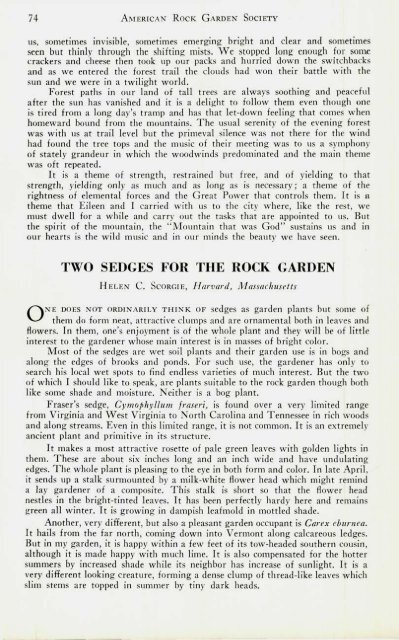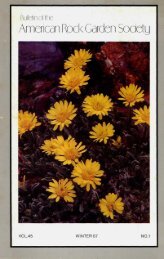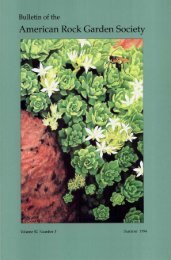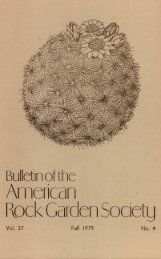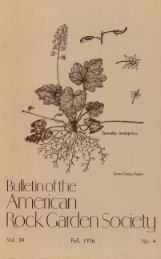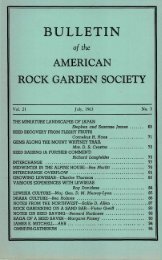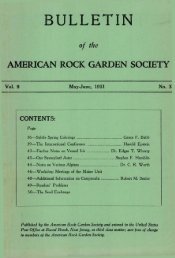Bulletin - July 1956 - North American Rock Garden Society
Bulletin - July 1956 - North American Rock Garden Society
Bulletin - July 1956 - North American Rock Garden Society
Create successful ePaper yourself
Turn your PDF publications into a flip-book with our unique Google optimized e-Paper software.
74 AMERICAN ROCK GARDEN SOCIETYus, sometimes invisible, sometimes emerging bright and clear and sometimesseen but thinly through the shifting mists. We stopped long enough for somecrackers and cheese then took up our packs and hurried down the switchbacksand as we entered the forest trail the clouds had won their battle with thesun and we were in a twilight world.Forest paths in our land of tall trees are always soothing and peacefulafter the sun has vanished and it is a delight to follow them even though oneis tired from a long day's tramp and has that let-down feeling that comes whenhomeward bound from the mountains. The usual serenity of the evening forestwas with us at trail level but the primeval silence was not there for the windhad found the tree tops and the music of their meeting was to us a symphonyof stately grandeur in which the woodwinds predominated and the main themewas oft repeated.It is a theme of strength, restrained but free, and of yielding to thatstrength, yielding only as much and as long as is necessary; a theme of therightness of elemental forces and the Great Power that controls them. It is atheme that Eileen and I carried with us to the city where, like the rest, wemust dwell for a while and carry out the tasks that are appointed to us. Butthe spirit of the mountain, the "Mountain that was God" sustains us and inour hearts is the wild music and in our minds the beauty we have seen.TWOSEDGES FOR THE ROCK GARDENHELEN C. SCORGIE, Harvard,MassachusettsNE DOES NOT ORDINARILY THINK OF sedges as garden plants but some ofthem do form neat, attractive clumps and are ornamental both in leaves andflowers. In them, one's enjoyment is of the whole plant and they will be of littleinterest to the gardener whose main interest is in masses of bright color.Most of the sedges are wet soil plants and their garden use is in bogs andalong the edges of brooks and ponds. For such use, the gardener has only tosearch his local wet spots to find endless varieties of much interest. But the twoof which I should like to speak, are plants suitable to the rock garden though bothlike some shade and moisture. Neither is a bog plant.Fraser's sedge, Cymophyllum fraseri, is found over a very limited rangefrom Virginia and West Virginia to <strong>North</strong> Carolina and Tennessee in rich woodsand along streams. Even in this limited range, it is not common. It is an extremelyancient plant and primitive in its structure.It makes a most attractive rosette of pale green leaves with golden lights inthem. These are about six inches long and an inch wide and have undulatingedges. The whole plant is pleasing to the eye in both form and color. In late April,it sends up a stalk surmounted by a milk-white flower head which might reminda lay gardener of a composite. This stalk is short so that the flower headnestles in the bright-tinted leaves. It has been perfectly hardy here and remainsgreen all winter. It is growing in dampish leafmold in mottled shade.Another, very different, but also a pleasant garden occupant is Carex eburnea.It hails from the far north, coming down into Vermont along calcareous ledges.But in my garden, it is happy within a few feet of its tow-headed southern cousin,although it is made happy with much lime. It is also compensated for the hottersummers by increased shade while its neighbor has increase of sunlight. It is avery different looking creature, forming a dense clump of thread-like leaves whichslim stems are topped in summer by tiny dark heads.


